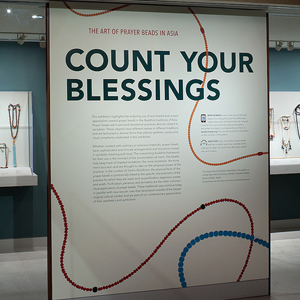
This exhibition focuses on aesthetic and ritual aspects of the prayers beads used in Buddhist traditions of Tibet, Bhutan, Mongolia, China, Korea, Japan, Thailand and Burma. It addresses the origins of prayer beads 108 beads in a set, the structure of prayer beads, their materials and symbolism, and status versus practice aspects of their use.
As expressions of individual’s practice, they often reflect the most personal in their form, additions, and embellishments. Among almost 80 sets of long and short strings of beads with flourishes, counters, attachments, and tassels that are on view, some are made of various seeds, simple or carved wood, while other are made of ivory, bone, or human cranium. Whether made of simple or precious materials, prayer beads reveal highly sophisticated and complex arrangements and structure rooted in their symbolic meanings and ritual use.
Most of these spectacular objects come from a private collection of Anne Dorsey largely donated and partly loaned to the Rubin Museum. Two complementing sets of beads are lent by Alice S. Kandell. A few select loans from the Mingei International Museum in San Diego and Robert J. Del Bontà provide a point of reference of perhaps more familiar forms and uses of Christian, Islamic, and Hindu prayer beads. From the collection of the Rubin Museum, Tibetan scroll paintings (thangka) of subjects holding prayer beads as their prominent attributes balance the presentation of mostly three-dimensional objects.
A key feature of the wifi-enabled exhibition space is the opportunity it offers visitors to, read and listen to descriptions and stories behind the prayers beads on display using their own hand-held devices.
Curated by Elena Pakhoutova
Support of this exhibition has been provided by the Ellen Bayard Weedon Foundation and by the 2013 Exhibitions Fund.
Plan your visit
Send Your Comments
Comments are moderated, and will not appear on this site until the Rubin has approved them.


